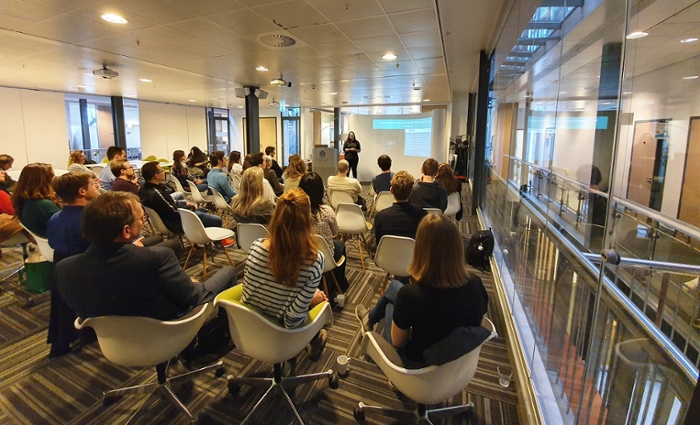
From energy transition to green infrastructure in The Hague: students and municipalities join forces
Can students help make our cities more sustainable and resilient? The Resilient Cities Hub thinks so: during its knowledge café on 16 January, passionate students talked to municipal officials and pitched their master’s research. ‘In this way, the students learn to step out of the academic world and into the real world.’
In the middle of society
How can we get rid of gas? And how can we use greenery in the city in such a way that it provides relaxation and recreation, but also helps against flooding and the heat island effect? These and other issues regarding sustainable urban development drive the Resilient Cities Hub (see box). This hub operates as a broker and developer of knowledge, in which students and scientists deal with questions that arise at the municipalities of Leiden and The Hague, and the urban mining collective New Horizon. ‘Our solutions can be applied in practice because we look at an issue from different angles,’ explains hub coordinator and industrial ecologist Benjamin Sprecher to some thirty attendees of the knowledge café. ‘Coherent thinking about a city from a scientific basis, that’s what this hub is about.’

Months of research in one minute
After Sprecher’s introduction, the students are up. In so-called one-minute elevator pitches, they present the results of their master’s thesis. Twitching fingers, skipping voices, tense postures: some of the dozen students look nervous. They tell briefly about their research, which varies from circular building and the green infrastructure in The Hague to the sustainable cooling of buildings and the energy transition in Leiden.

Making an impact
Of course, the eight municipal officials at the knowledge café need more than one-minute talks, so the rest of the morning the students present their results with posters. And that results in good conversations: while the students share their insights and solutions, the officials tell their side of the story. They explain why they have to make certain decisions and what practical considerations are involved.
This cross-pollination is exactly what Sprecher aims for. ‘We can make a real impact. The previous batch of students even presented for the city council.’ But Sprecher dreams of more: ‘I want to see physical results. The students have been working hard on this for years, so it would be fantastic if that would produce something tangible in the city, such as more greenery in a place which has been calculated as optimal by us.’

‘Their motivation is almost tangible’
An official of the municipality of The Hague notices the enthusiasm of the students. ‘They are really driven to do their research, their motivation is almost tangible. I think it’s good that this collaboration exists.’ Nevertheless, he also sees areas for improvement. ‘As an official, I would like to be more involved in an issue, for example by giving my input beforehand and during the investigation. But I understand that the educational value is the most important component of this project.’

From the real world to the virtual world
You can see it as a paradox: while the students talk to civil servants and dive into the ‘real’ world, Berlin-based artist Anne Bengard creates a virtual world on the spot. She has selected two theses that she visualises. With the help of VR glasses, the attendees step into the virtual world: a leafy bottom, a page from the thesis, flashy blue lines and even a meters-high tree. In this way, the virtual world helps to provide insight into real social problems and solutions.
Resilient Cities Hub
The Resilient Cities Hub exists since 2016 and is part of the Institute of Environmental Sciences. The issues are largely the result of workshop sessions that the hub holds every summer with interested municipal officials. Students from all programmes are welcome. Most of them come from the master’s programme Industrial Ecology, but there are also students from the Rotterdam master’s programme in Global Business & Sustainability and the Delft master’s programme Sustainable Energy Technology. Every year, about ten students start working at the hub and as many scientists are involved in supervising these students. So far the project has produced 14 theses and 8 reports.
Text and images: Bryce Benda
